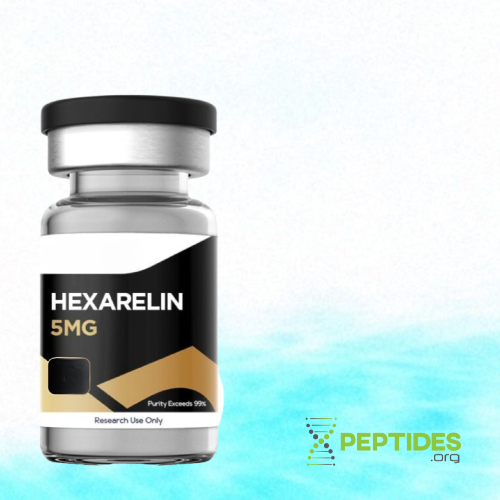Buy Hexarelin Online | 99% Purity | USA-Made

Hexarelin is a synthetic growth hormone-releasing peptide (GHRP) consisting of six amino acids. It exhibits powerful effects on pulsatile GH release with minimal side effects and dose-dependent, reversible desensitization of GH response. The peptide’s effect on GH promotes visceral fat reduction, lean tissue growth, and better sleep and recovery. Hexarelin is also researched for potential cardioprotective, neuroprotective, and healing benefits.
Availability: In-Stock
Price: $45.98
- FREE Shipping for orders over $200 (USA Only)
- $9.25 Flat Rate Shipping, USA Orders
- Includes one 30mL Bacteriostatic Water with orders over $200

What is Hexarelin?
Hexarelin is a synthetic hexapeptide that mimics ghrelin, the body’s natural gut hormone. It acts on the growth hormone secretagogue receptor (GHS-R) to trigger the release of growth hormone [1].
The growth hormone release resulting from hexarelin treatment can improve the body’s ability to produce collagen, repair ligaments and tendons, grow muscle fibers, reduce visceral body fat, and increase bone density [2, 3].
While hexarelin is a ghrelin analog, studies have found that hexarelin is a superior alternative to ghrelin therapy because of its potency and stability, particularly as a cardioprotective agent [4].
The administration of hexarelin has also been shown to provide neuroprotective benefits such as promoting the growth of new brain cells, protecting healthy brain cells, and reducing inflammation in the brain [5].
Below we will explore some of the common reasons researchers are interested in further studies on hexarelin.

Hexarelin Benefits and Uses
Hexarelin is frequently sought out for its marked effects on fat loss and muscle-building. Its ability to affect insulin sensitivity, energy production, and lean muscle growth makes it an attractive compound for researchers wishing to enhance the body composition of their subjects.
Hexarelin for Fat Reduction
Hexarelin is known to activate the CD36 receptor, which is responsible for fatty acid uptake, conversion, and distribution [6]. Studies have shown that the action of hexarelin on CD36 improves the conversion of fat to energy within adipocytes while also increasing the production of cellular mitochondria [7]. This enables subjects to release excess visceral fat and utilize it for energy.
Another way hexarelin aids in fat reduction is by improving insulin sensitivity, which is correlated with successful weight loss and maintenance [8]. Again because of its affinity at the CD36 receptor, hexarelin has been shown to improve the body’s response to circulating insulin, allowing blood glucose to be disposed of or used for energy efficiently [9].
It is worth noting that even lean individuals can experience abnormal fat distribution, suboptimal fat metabolism, and unfavorable blood lipid profiles. These subjects can still benefit from hexarelin therapy as the peptide may improve all aforesaid markers independent of its effect on fat loss [9].
Hexarelin for Muscle Growth
Hexarelin-induced pulsatile growth hormone release encourages the body to achieve a desirable lean mass ratio [10]. Growth hormone is vital for lean tissue growth, and there is a compounding effect on lean mass gain and retention over time when GH therapy is combined with consistent resistance training [11].
Similar to its mitochondrial production within adipocytes, hexarelin has been shown to increase mitochondria in rat skeletal muscle cells along with promoting healthy cell turnover. This effect was maximized by providing stimulus to the muscle through weight training [12]. With more exercise, more lean mass, and less body fat, the body produces more GH in response to hexarelin treatment and is more sensitive to that GH release [13].
Hexarelin for Heart Health
There are numerous cardiovascular applications of hexarelin. One of these may be aiding cardiac function during bypass surgery.
In one study, 24 male patients with coronary artery disease underwent bypass surgery. During surgery, the patients received one of four intravenous treatments: placebo, GH-releasing hormone, recombinant human GH, or hexarelin. Certain cardiac performance biomarkers were monitored to assess the benefits of each treatment.
Only the subjects treated with hexarelin showed favorable changes in wedge pressure, (Left ventricular ejection fraction) LVEF, cardiac index, and cardiac output. Additionally, hexarelin left heart rate and systemic vascular resistance index unchanged, and elicited a minimal elevation in levels of GH. The researchers concluded that hexarelin could benefit patients undergoing bypass surgery because of its selective activation of GHS-Rs within the cardiovascular system [14].
Hexarelin Side Effects and Safety
Hexarelin appears to be relatively safe due to its ability to stimulate favorable growth hormone release without overly affecting other hormones. However, there are a few side effects and facts to be aware of.
For one, since the research on hexarelin has been limited mostly to in vitro studies, the United States Food and Drug Administration (FDA) has yet to approve the peptide for use by humans [15].
As of 2022, hexarelin is listed as a prohibited substance by the World Anti-Doping Agency and similar regulatory bodies. Competitive athletes are thus advised to refrain from participating in hexarelin research [16].
In terms of side effects, growth hormone release triggered by hexarelin injections may cause fatigue or lethargy [17].
Because hexarelin is most commonly administered as a subcutaneous injection, it comes with the following risks [18]:
- Redness, swelling, bruising, or pain at the injection site
- Risk of infection
- Accidental injection into a blood vessel
If chronically used in larger-than-necessary doses, hexarelin can cause spikes in growth hormone that may result in downstream adverse effects such as joint pain, insulin resistance, and hypertension [19, 20].
Long-term use of hexarelin can cause partial desensitization of the body’s response to treatment, which is reversible once administration ceases [21].
Following a science-backed hexarelin dosing cycle and paying careful attention to hygiene during administration can help researchers minimize or avoid side effects
Hexarelin Dosing and Administration
Hexarelin is usually sold as a freeze-dried powder contained within a sterile vial.
Reference Hexarelin Dosing Protocol
Based on the limited number of hexarelin clinical studies available, the recommended dosing schedule for hexarelin for improving body composition is a 100mcg injection delivered three times daily for a total dose of 300mcg per day [19, 22].
For reference purposes, here is the dosing protocol outlined in greater detail:
- Hexarelin Dose: 300mcg, split into three daily doses of 100mcg each.
- Frequency: Administer hexarelin as three subcutaneous injections spaced evenly throughout the day (e.g., first 100mcg injection at 8:00am, second 100mcg injection at 12:00pm, third subcutaneous injection at 4:00pm).
- Study Duration: 16 weeks (12 weeks of injections, 4 weeks of no injections).
- Repeat Cycle: as needed to achieve desired effects.
- Notes: Subjects should refrain from ingesting food at least 60 minutes before and after each injection.
This dosage can be administered for a period of 12 weeks before taking a 4-week break. Studies have shown that desensitization to hexarelin occurs between 4 and 16 weeks of administration, but that this effect is reversible after four weeks of no treatment [21].
Where to Buy Hexarelin Online? | 2024 Edition
Finding a trusted source for buying research chemicals like hexarelin can be a challenge. To ensure a smooth acquisition process, researchers must vet potential sources in relation to aspects like:
- Product testing and quality
- Pricing and bulk discounts
- Shipping times
- Customer care and related policies
Luckily, our team of reviewers at Peptides.org has extensive industry knowledge and experience, and are pleased to recommend the top hexarelin vendor out there.
PureRawz
PureRawz is our go-to supplier for hexarelin and many other compounds for the following reasons:
- Product Purity: PureRawz provides researchers with a full third-party laboratory testing for hexarelin. Researchers can rest assured that this vendor’s hexarelin is pure and potent.
- Affordability: PureRawz keeps the costs of its products to a minimum, guaranteeing a low flat-rate shipping fee within the U.S., which is waived on orders over $100.
- Support: When researchers have questions about their purchases, shipping, or any other aspect of their interaction, they may reach out to PureRawz' dedicated service team by email.
With a reputation for providing the peptide research community with pure, safe, and fairly priced compounds, PureRawz is a great choice for researchers looking to buy hexarelin online.
Buy Hexarelin from our top-rated vendor...

How Much Does Hexarelin Cost?
Based on a data-supported dosing regimen, our team has compiled a cost estimate for a researcher to administer 300mcg hexarelin/daily, divided into 3 x 100mcg doses, for 12 weeks:
Six 5mg vials of hexarelin = $275.88
Ideally, researchers would reconstitute one 5mg vial of hexarelin with 1ml of bacteriostatic water. Then this solution would be stored under the proper conditions. Refer to our dosing calculator for guidance on how to draw up the proper 100mcg dose of hexarelin after it has been reconstituted.
Once the first vial of hexarelin has been depleted, the researcher can prepare a second vial. Following this procedure ensures that the solution retains its potency and freshness, as it will degrade significantly after 28 days [23]. This allows researchers to avoid wasting products and to extract the maximum benefit from their investment.
FAQ
Is hexarelin a steroid?
No, hexarelin is not a steroid. Anabolic steroids increase testosterone production and carry a high risk of adverse effects [25]. Hexarelin is a growth hormone-secreting peptide that enhances the body’s natural GH production and does not affect other hormones when administered in the proper doses.
Will hexarelin cause weight gain?
There is a possibility that researchers will notice an increase in subjects’ lean body mass, which could lead to weight gain. Hexarelin does not cause an increase in appetite but does improve fat metabolism, so any weight gain is unlikely to be from fat.
Is hexarelin legal?
Hexarelin is not approved for use in humans, but it is legal to purchase and use hexarelin for laboratory research purposes.
Bacteriostatic Water and Hexarelin
Bacteriostatic water is superior to sterile water when reconstituting peptides. This is because bacteriostatic water contains the preservative benzyl alcohol, it prolongs the shelf life of solutions by preventing bacterial contamination [24].
Hexarelin For Sale | Overall
Hexarelin is a GHRP with activity in the pituitary and endocrine pathways. Its properties interest peptide researchers and clinicians for its abilities to improve body composition in addition to its cardioprotective potential.
This peptide may also have implications for use in the treatment of diabetes, improving the lives of chemotherapy patients, and reversing hypertension, just to name a few possibilities.
While clinical trials are sparse, research on hexarelin to date has demonstrated that it carries few side effects. Most adverse effects are dose-dependent and reversible.
Licensed researchers may buy hexarelin online for inclusion into their studies. Our team fully endorses this vendor for its responsibly made, thoroughly tested, and highly potent hexarelin and other research chemicals.

References
- Lanfranco, F., Motta, G., Baldi, M., Gasco, V., Grottoli, S., Benso, A., Broglio, F., & Ghigo, E. (2010). Ghrelin and Anterior Pituitary Function. Frontiers of Hormone Research, 38, 206–211. https://doi.org/10.1159/000318512
- Kopchick, J. J., Berryman, D. E., Puri, V., Lee, K. Y., & Jorgensen, J. O. L. (2020). The Effects of Growth Hormone on Adipose Tissue: Old Observations, New Mechanisms. Nature Reviews. Endocrinology, 16(3), 135–146. https://doi.org/10.1038/s41574-019-0280-9
- Doessing, S., Heinemeier, K. M., Holm, L., Mackey, A. L., Schjerling, P., Rennie, M., Smith, K., Reitelseder, S., Kappelgaard, A. M., Rasmussen, M. H., Flyvbjerg, A., & Kjaer, M. (2010). Growth Hormone Stimulates the Collagen Synthesis in Human Tendon and Skeletal Muscle Without Affecting Myofibrillar Protein Synthesis. The Journal of Physiology, 588(2), 341–351. https://doi.org/10.1113/jphysiol.2009.179325.
- Mao, Y., Tokudome, T., & Kishimoto, I. (2014). The Cardiovascular Action of Hexarelin. Journal of Geriatric Cardiology, 11(3), 253–258. https://doi.org/10.11909/j.issn.1671-5411.2014.03.007
- Meanti, R., Licata, M., Rizzi, L., Bresciani, E., Molteni, L., Coco, S., Locatelli, V., Omeljaniuk, R. J., & Torsello, A. (2023). Protective Effects of Hexarelin and JMV2894 in a Human Neuroblastoma Cell Line Expressing the SOD1-G93A Mutated Protein. International Journal of Molecular Sciences, 24(2), 993. https://doi.org/10.3390/ijms24020993
- Pepino, M. Y., Kuda, O., Samovski, D., & Abumrad, N. A. (2014). Structure-Function of CD36 and Importance of Fatty Acid Signal Transduction in Fat Metabolism. Annual Review of Nutrition, 34, 281–303. https://doi.org/10.1146/annurev-nutr-071812-161220
- Rodrigue-Way, A., Demers, A., Ong, H., & Tremblay, A. (2007). A Growth Hormone-Releasing Peptide Promotes Mitochondrial Biogenesis and a Fat Burning-Like Phenotype Through Scavenger Receptor CD36 in White Adipocytes. Endocrinology, 148(3), 1009–1018. https://doi.org/10.1210/en.2006-0975
- Clamp, L. D., Hume, D. J., Lambert, E. V., & Kroff, J. (2017). Enhanced Insulin Sensitivity in Successful, Long-Term Weight Loss Maintainers Compared With Matched Controls With No Weight Loss History. Nutrition & Diabetes, 7(6), e282. https://doi.org/10.1038/nutd.2017.31
- Mosa, R., Huang, L., Wu, Y., Fung, C., Mallawakankanamalage, O., LeRoith, D., & Chen, C. (2017). Hexarelin, a Growth Hormone Secretagogue, Improves Lipid Metabolic Aberrations in Nonobese Insulin-Resistant Male MKR Mice. Endocrinology, 158(10), 3174–3187. https://doi.org/10.1210/en.2017-00168.
- Huang, Z., Lu, X., Huang, L., Zhang, C., Veldhuis, J. D., Cowley, M. A., & Chen, C. (2021). Stimulation of Endogenous Pulsatile Growth Hormone Secretion By Activation of Growth Hormone Secretagogue Receptor Reduces the Fat Accumulation and Improves the Insulin Sensitivity in Obese Mice. FASEB Journal: Official Publication of the Federation of American Societies for Experimental Biology, 35(1), e21269. https://doi.org/10.1096/fj.202001924RR
- Kraemer, W. J., Ratamess, N. A., Hymer, W. C., Nindl, B. C., & Fragala, M. S. (2020). Growth Hormone(s), Testosterone, Insulin-Like Growth Factors, and Cortisol: Roles and Integration for Cellular Development and Growth With Exercise. Frontiers in Endocrinology, 11, 33. https://doi.org/10.3389/fendo.2020.00033
- Sirago, G., Conte, E., Fracasso, F., Cormio, A., Fehrentz, J. A., Martinez, J., Musicco, C., Camerino, G. M., Fonzino, A., Rizzi, L., Torsello, A., Lezza, A. M. S., Liantonio, A., Cantatore, P., & Pesce, V. (2017). Growth Hormone Secretagogues Hexarelin and JMV2894 Protect Skeletal Muscle from Mitochondrial Damages in a Rat Model of Cisplatin-Induced Cachexia. Scientific Reports, 7(1), 13017. https://doi.org/10.1038/s41598-017-13504-y
- Rahim, A., O'Neill, P., & Shalet, S. M. (1998). The Effect of Body Composition on Hexarelin-Induced Growth Hormone Release in Normal Elderly Subjects. Clinical Endocrinology, 49(5), 659–664. https://doi.org/10.1046/j.1365-2265.1998.00586.x
- Broglio, F., Guarracino, F., Benso, A., Gottero, C., Prodam, F., Granata, R., Avogadri, E., Muccioli, G., Deghenghi, R., & Ghigo, E. (2002). Effects of acute hexarelin administration on cardiac performance in patients with coronary artery disease during by-pass surgery. European journal of pharmacology, 448(2-3), 193–200. https://doi.org/10.1016/s0014-2999(02)01934-9
- Sigalos, J. T., & Pastuszak, A. W. (2018). The Safety and Efficacy of Growth Hormone Secretagogues. Sexual Medicine Reviews, 6(1), 45–53. https://doi.org/10.1016/j.sxmr.2017.02.004
- Raising the game for Clean Sport. World Anti-Doping Agency. (2022). https://www.wada-ama.org/sites/default/files/resources/files/2022list_final_en.pdf
- Frieboes, R. M., Antonijevic, I. A., Held, K., Murck, H., Pollmächer, T., Uhr, M., & Steiger, A. (2004). Hexarelin Decreases Slow-Wave Sleep and Stimulates the Secretion of GH, ACTH, Cortisol and Prolactin During Sleep in Healthy Volunteers. Psychoneuroendocrinology, 29(7), 851–860. https://doi.org/10.1016/S0306-4530(03)00152-5
- Villines, Z. (2018). Subcutaneous Injection: Definition and What To Expect (D. Weatherspoon, Ed.). Medical News Today. https://www.medicalnewstoday.com/articles/322710#complications
- Massoud, A. F., Hindmarsh, P. C., & Brook, C. G. (1996). Hexarelin-Induced Growth Hormone, Cortisol, and Prolactin Release: A Dose-Response Study. The Journal of Clinical Endocrinology and Metabolism, 81(12), 4338–4341. https://doi.org/10.1210/jcem.81.12.8954038
- Hintz R. L. (2004). Growth Hormone: Uses and Abuses. BMJ (Clinical Research Ed.), 328(7445), 907–908. https://doi.org/10.1136/bmj.328.7445.907
- Rahim, A., & Shalet, S. M. (1998). Does Desensitization to Hexarelin Occur? Growth Hormone & IGF Research: Official Journal of The Growth Hormone Research Society and The International IGF Research Society, 8 Suppl B, 141–143. https://doi.org/10.1016/s1096-6374(98)80039-7.
- Imbimbo, B. P., Mant, T., Edwards, M., Amin, D., Dalton, N., Boutignon, F., Lenaerts, V., Wüthrich, P., & Deghenghi, R. (1994). Growth Hormone-Releasing Activity of Hexarelin In Humans. A Dose-Response Study. European Journal of Clinical Pharmacology, 46(5), 421–425. https://doi.org/10.1007/BF00191904.
- Peptide Handling, Dissolution, and Storage. NIBSC. (2003). https://www.nibsc.org/science_and_research/virology/cjd_resource_centre/available_samples/peptide_library/peptide_storage.aspx.
- National Institutes of Health. (2014). Bacteriostatic Water. U.S. National Library of Medicine. https://dailymed.nlm.nih.gov/dailymed/fda/fdaDrugXsl.cfm?setid=ccadcf46-6a6f-436b-9bbc-17e2983a335f&type=display.
- U.S. Department of Health and Human Services. (2023). Anabolic Steroids and Other Appearance and Performance Enhancing Drugs (APEDs). National Institutes of Health. https://nida.nih.gov/research-topics/anabolic-steroids#types
There are no reviews yet. Be the first one to write one.
